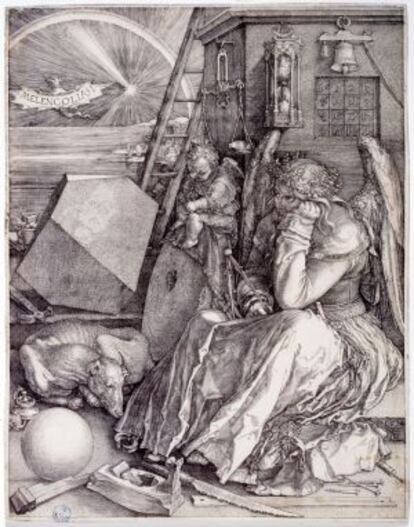Dürer’s chiseled riddles
Unraveling the mysteries of the German artist's engravings

There's something about the precision and detail of engraving that makes you search for hidden messages. Nowhere more so than in the etchings, wood engravings, prints and books of German genius Albrecht Dürer (1471-1528), 122 of which are now on show at the National Library in Madrid.
You only need to head straight to his trio of master prints, Knight, Death and the Devil , Melencolia I and Saint Jerome in his Study, to be confronted with a wealth of mystery. Was Dürer aiming to produce a study of man's four temperaments, as the title of the second print and the S, for sanguine, situated to the side of the date on the first suggest? If so, why did he decide not to finish, or preserve, the fourth of the series, the choleric? What does the Roman numeral accompanying the word Melencolia mean? And above all, what sort of riddle was he posing with the magic square placed over the head of the winged woman, the rows, columns and diagonals of which always add up to 34?
The turn of the 16th century was a time full of questions without answers. Secret anabaptist societies were practicing adult baptisms behind closed doors, pigs with two heads were born, never-before-seen beasts known as rhinoceroses were arriving in Europe from the Orient and everyone was in the grip of a superstitious fear over the imminent arrival of the year 1500. And the tremors of a turbulent time were by no means unconnected with Dürer's engraving work, which provided a decent way for him to earn a living.
The exhibition begins by placing Dürer's work in its historical context, featuring a chronological journey through the different engraving schools in the Germany of the era: Nuremberg, Augsburg, Basel, Strasbourg and Saxony, where you find the work of artists such as Hans Holbein, Lucas Cranach, Hans Baldung and Albrecht Aldorfer.
Afterwards, it meanders through the life of Dürer and his wife Agnes, who had no offspring; their educational and business trips to the likes of Italy and the Netherlands; and the books that won them fame: his startling interpretation of the Apocalypse and meticulous treatise Four Books on Human Proportion, which would be published posthumously.
Durero grabador. Del Gótico al Renacimiento . Until May 5 at Biblioteca Nacional de España, Pº de Recoletos 20-22, Madrid. www.bne.es
Tu suscripción se está usando en otro dispositivo
¿Quieres añadir otro usuario a tu suscripción?
Si continúas leyendo en este dispositivo, no se podrá leer en el otro.
FlechaTu suscripción se está usando en otro dispositivo y solo puedes acceder a EL PAÍS desde un dispositivo a la vez.
Si quieres compartir tu cuenta, cambia tu suscripción a la modalidad Premium, así podrás añadir otro usuario. Cada uno accederá con su propia cuenta de email, lo que os permitirá personalizar vuestra experiencia en EL PAÍS.
¿Tienes una suscripción de empresa? Accede aquí para contratar más cuentas.
En el caso de no saber quién está usando tu cuenta, te recomendamos cambiar tu contraseña aquí.
Si decides continuar compartiendo tu cuenta, este mensaje se mostrará en tu dispositivo y en el de la otra persona que está usando tu cuenta de forma indefinida, afectando a tu experiencia de lectura. Puedes consultar aquí los términos y condiciones de la suscripción digital.








































